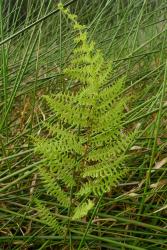- ≡ Pteris confluens Thunb., Prodr. Pl. Cap. 171 (1800)
- = Aspidium thelypteris var. squamigerum Schltdl., Adumbr. Fil. 23, t. 11 (1825)
- ≡ Aspidium squamigerum (Schltdl.) Fée, Mém. Foug., 8. d. Esp. Nouv. 104 (1857)
- ≡ Thelypteris palustris var. squamigera (Schltdl.) Weath. in Johnston, Contr. Gray Herb. 73: 40 (1924)
- ≡ Thelypteris squamigera (Schltdl.) Ching, Bull. Fan Mem. Inst. Biol. 6: 329 (1936) – as squamulosa
- = Nephrodium squamulosum Hook.f., Bot. Antarct. Voy. II (Fl. Nov.-Zel.) Part II, 39 (1854)
- ≡ Nephrodium thelypteris var. squamulosum (Hook.f.) Hook., Sp. Fil. 4, 88 (1862)
- ≡ Dryopteris thelypteris var. squamulosum (Hook.f.) Cheeseman, Man. New Zealand Fl., ed. 2, 33 (1925)
- = Lastrea invisa J.B.Armstr., Trans. & Proc. New Zealand Inst. 13: 359 (1881)
Rhizomes long-creeping, up to 175 mm long (in herbarium specimens) with stipes arising 8–37 mm apart, 1.5–3 mm diameter, bearing scattered scales. Rhizome scales ovate to broadly ovate, 1–3 mm long, 0.5–1.5 mm wide, pale brown, entire. Fronds 380–1150 mm long, held stiffly upright. Stipes 180–670 mm long, yellow-brown to chestnut-brown and often almost black at the base, glabrous or scaly near base, slightly polished. Laminae sometimes appearing slightly dimorphic with fertile pinna segments inrolled and a little narrower than the sterile, deeply 1-pinnate-pinnatifid to 1-pinnate-pinnatisect, narrowly elliptic to elliptic, or rarely narrowly obovate, usually narrowed to a short pinnatisect apex, 150–540 mm long, 40–145 mm wide, mid-green on both surfaces, herbaceous to coriaceous. Broadly ovate or broadly elliptic or almost orbicular pale brown scales on abaxial surface of pinna midribs and costae; colourless, acicular hairs and short-stalked glands up to 1 mm long on both surfaces of costae and veins. Primary pinnae in 14–27 pairs, widely spaced especially proximally, narrowly elliptic or narrowly ovate to almost oblong; the longest at about mid-lamina, short-stalked, 25–80 mm long, 6–18 mm wide; the basal pair not or scarcely reduced in length. Primary pinnae divided almost, or rarely completely, to the midrib; ultimate segments oblong, 3–10 mm long, 1.5–3 mm wide, apices acute to obtuse, margins usually inrolled, bases adnate to decurrent. Veins all free, forking in sterile pinna segments, undivided in fertile segments. Sori round, in one row either side of midrib away from pinna margins; indusia reniform, 0.4–0.6 mm diameter, bearing short-stalked glands.
Thelypteris confluens is recognised by its long-creeping rhizomes, rigidly erect fronds, deeply 1-pinnate-pinnatifid to 1-pinnate-pinnatisect laminae, pinnae divided almost to the midribs, basal pair of pinnae not reduced in length, free veins, indumentum on the abaxial surfaces comprising broad scales, acicular hairs and short-stalked glands, and indusia bearing short-stalked glands.
North Island: Northland, Auckland, Volcanic Plateau
Altitudinal range: 0–300 m.
Thelypteris confluens occurs in lowland areas of the northern North Island from near North Cape to the Bay of Plenty and Rotorua district, with an outlying population at Lake Rotokawa near Taupō. It mostly grows close to sea level but extends to 300 m at Lake Rotoehu, near Rotorua.
Also tropical and subtropical regions of Africa, Madagascar, India, south-east Asia, Malesia and Australia (Queensland, Victoria) (Holttum 1977). Naturalised in Argentina (Zuloaga et al. 2008).
Confined to lake, swamp and marsh vegetation, or on peat in raised bogs; mostly found within dune slacks and their associated wetlands, sometimes found under mānuka, willows or pines, or rarely on old Carex mounds in open sunny sites; often associated with Typha orientalis, Machaerina juncea, Eleocharis acuta, Isachne globosa, Isolepis prolifera, Apodasmia similis, Cyclosorus interruptus and Blechnum minus. It is largely confined to coastal areas, but extends inland in wetlands on geothermally heated soils in the southern part of its range.
The species was given a conservation status of 'At Risk / Naturally Uncommon' by de Lange et al. (2018).
2n = 70 (de Lange et al. 2004).








